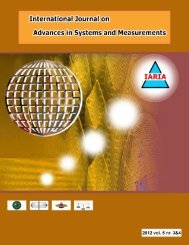Fault Tolerance Framework using Model-Based - IARIA Journals
Fault Tolerance Framework using Model-Based - IARIA Journals
Fault Tolerance Framework using Model-Based - IARIA Journals
You also want an ePaper? Increase the reach of your titles
YUMPU automatically turns print PDFs into web optimized ePapers that Google loves.
International Journal on Advances in Security, vol 4 no 1 & 2, year 2011, http://www.iariajournals.org/security/<br />
takes the control of the execution, thereby enabling<br />
the execution to continue, see Figure 5. The binder<br />
backup can be an exact copy of the original but<br />
located in another external server or machine that of<br />
the primary copy. BPEL provides various mechanisms,<br />
such as fault and compensation handlers, to achieve<br />
the implementation of primary-backup binders.<br />
Figure 5. Communication process-service with binder replicated.<br />
3) Multi-Version (N-Version Programming) approach<br />
Software components cannot be degraded in the same<br />
way as physical systems and redundancy fails to<br />
provide a good solution, since if a fault is detected in<br />
a software component, it is due to an implementation<br />
fault with a very high probability, and this kind of fault<br />
cannot be solved by means of redundancy. Diversity<br />
is a very important factor in obtaining dependable<br />
software systems [18]. The main goal of diversity is<br />
to provide identical services (variants) but with a separate<br />
design and implementation in order to minimize<br />
ca<strong>using</strong> identical faults. For instance, when a software<br />
variant presents a fault, this will be isolated as much<br />
as possible. There are different techniques for faulttolerance<br />
software based on multi-version (diversity<br />
of software) [18][34]: N-Version Programming (NVP),<br />
Recovery Blocks, N-Self Checking Programming.<br />
In the proposed framework, a solution based on NVP<br />
is adopted, which is a static technique where a activity<br />
is executed by various processes or programs and the<br />
result is only accepted by majority of votes. This<br />
mechanism for obtaining results is defined in NVP as<br />
an adjudicator or decision mechanism (DM). Various<br />
decision mechanisms are defined in [18].<br />
The N-Version paradigm considers the utilization of<br />
diversity for implementations and designs in order to<br />
isolate faults in the components. Every service used<br />
in the implementation will be developed as an N-<br />
Version Component. The implementation selected for<br />
N-Version components follow the basic ideas of N-<br />
Version Programming. An N-Version component provides<br />
at most 2X + 1 replicas, X ranges from 1 to N,<br />
and where N is an integer greater than 1. Components<br />
have been developed with an adjudicator (DM) in<br />
order to obtain the output results, see Figure 6. The<br />
logic within the adjudicator (DM) can be very basic<br />
or seriously complicated. However, NVP components<br />
can be improved by adding new features, for example,<br />
by developing new strategies in the adjudicator. However,<br />
the more complexity added into the adjudicator<br />
component, the more overhead is introduced into the<br />
execution of the N-Version components.<br />
Figure 6. Example of N-Version component.<br />
By <strong>using</strong> N-Version components, not only is faulttolerance<br />
achieved, but it also supposes another advantage<br />
since the diagnosis stage is rendered totally<br />
unnecessary. For example, if one of the variants fails<br />
return a response in time, the adjudicator takes the<br />
results from the other variants. In consequence, diagnosis<br />
can be eliminated from the framework by <strong>using</strong><br />
this mechanism, although it could result in a very high<br />
cost in developing and performance.<br />
4) Checkpointing approach<br />
The checkpoint mechanism is based on the idea of<br />
saving the state of the system, and, in the case of<br />
fault detection, recovering the execution of the system<br />
from the checkpoint where the state was saved. We<br />
propose the simulation of a checkpoint approach in<br />
services, whereby a recovery mechanism is launched<br />
only in the case of faults. The fault tolerance approach<br />
mechanism is composed of two parts:<br />
• Sensors (Checkpoints). An integrity sensor is<br />
modelled as a CSP. Sensors receive data information<br />
about data inputs and outputs from the<br />
services, with which the CSP is then defined. CSP<br />
resolutions help to identify and isolate the services<br />
which are failing in run-time.<br />
• Compensation handlers (Rollback). These are specific<br />
elements of business processes which allow<br />
the limitation of the effects created by a process<br />
when faults or errors occur. Compensation<br />
handlers allow the process execution to be rolled<br />
back from a specific point, thereby executing<br />
a set of tasks to undo the transactions already<br />
initiated. Compensation handlers are explained in<br />
next section.<br />
2011, © Copyright by authors, Published under agreement with <strong>IARIA</strong> - www.iaria.org<br />
16







